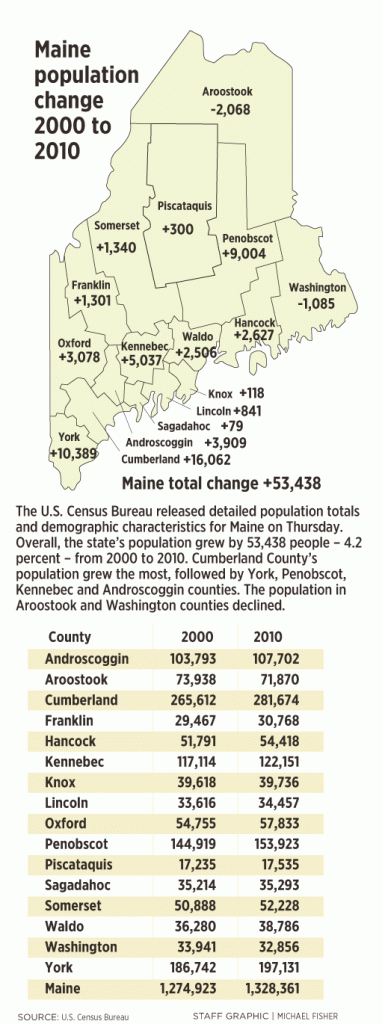Maine’s population grew by 53,438 people over the last decade, to more than 1.3 million, according to figures released Thursday by the U.S. Census Bureau.
At 4.2 percent, the state’s growth from 2000 to 2010 was in line with that of other states in the Northeast, said Thomas Merrill, an economist with the State Planning Office.
However, Maine trailed New Hampshire, which gained about 80,000 new residents over the decade — a growth rate of 6.5 percent, Merrill said.
Across the nation, growth was much faster in the South and West than in the Midwest and Northeast. Nevada was the fastest-growing state from 2000 to 2010, followed by Arizona, Utah, Idaho and Texas.
In the Northeast, Rhode Island had the slowest population growth, gaining just 4,248 residents.
Merrill said he spent much of Thursday analyzing the census data, which will be used to adjust federal and state legislative districts in 2013.
He said the information also is used in economic forecasting, state policy development, legislation, and communities’ development of comprehensive plans.
“There were not a lot of surprises in the state’s population figures,” Merrill said.
Cumberland County gained more people than any other county in Maine, 16,062, a growth rate of 6 percent. It remained the state’s most populous county, with 281,674 residents.
York is the state’s second-largest county, with a population of 197,131, followed by Penobscot, with 153,923, Kennebec, with 122,151, and Androscoggin, with a population of 107,702.
Waldo County, home to Belfast and Searsport, had Maine’s highest growth rate over the last 10 years — 6.9 percent. The county gained 2,506 residents, growing to about 38,786, Merrill said.
Belfast City Manager Joe Slocum said he’s not surprised that the county has become such a popular place to live. He suspects that many people chose to retire in the region.
“Belfast is a remarkable place to live,” he said, with the city’s scenic waterfront and arts district thriving.
A new boatyard that will refurbish and build yachts and employ more than 100 people is under development.
“People have come up to me and said Belfast still feels like Maine,” Slocum said. “Our biggest challenge is to continue to make this place wonderful while not driving away the people who grew up here.”
Merrill said the Portland suburbs of Gorham and Windham had strong growth during the decade, gaining 2,240 and 2,097 residents, respectively. Those towns were followed by Scarborough, with 1,949 more residents; South Portland, with 1,678; and Westbrook, which gained 1,352 residents.
“Portland used to be the hot spot. These figures may be an indication that these towns have developed their own unique town centers and aren’t just bedroom communities anymore,” Merrill said.
Portland, Maine’s largest city, grew by 3 percent, to 66,194 residents.
South Portland, with a population of 25,002, is the state’s fourth-largest city, behind Lewiston, with 36,592, and Bangor, with 33,039 residents.
Merrill said Brunswick, which is in Cumberland County, showed a “pronounced decline” in population, losing more than 900 residents over the 10-year period.
Brunswick, which now has a population of about 20,000, has been home to the Brunswick Naval Air Station and hundreds of military families for decades. But those families have moved away as the base has scaled back operations in anticipation of closing in May.
Aroostook and Washington counties, which are rural and far from major population centers, saw their populations decline. Aroostook has been losing residents since the 1960 census was taken.
Aroostook County lost 2,068 residents from 2000 to 2010; Washington County lost 1,085 residents, according to the census.
The primary reason for the sluggish showing in rural areas and strong growth in urban areas was pressure to move in search of jobs as paper mills and other manufacturing plants shut down or cut back, said Charles Colgan of the University of Southern Maine’s Muskie School of Public Service.
“The rural economy is stagnant or shrinking and the urban areas are growing,” Colgan said. “The net result is, people are moving from the rural areas to urban areas.”
Maine’s minority population is also growing.
In 2010, minorities made up about 5 percent of the state’s population, up from 3.1 percent in 2000. While the numbers are small, the gains are significant, Colgan said.
“When you consider that in the 1990 census we were only 1 percent minorities and now we’re nearly 5 percent minorities, that’s a noticeable change,” he said.
Maine’s black population grew the fastest — 128 percent — among the state’s minority groups, to 21,764, according to the census.
The increase reflects the influx of immigrants, particularly from Sudan and Somalia.
The Associated Press contributed to this report.
Staff Writer Dennis Hoey can be contacted at 791-6365 or at:
dhoey@pressherald.com
Send questions/comments to the editors.




Success. Please wait for the page to reload. If the page does not reload within 5 seconds, please refresh the page.
Enter your email and password to access comments.
Hi, to comment on stories you must . This profile is in addition to your subscription and website login.
Already have a commenting profile? .
Invalid username/password.
Please check your email to confirm and complete your registration.
Only subscribers are eligible to post comments. Please subscribe or login first for digital access. Here’s why.
Use the form below to reset your password. When you've submitted your account email, we will send an email with a reset code.